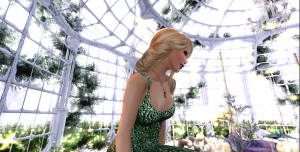
iSkye Silverweb
Peer support and peer-to-peer networking is fundamental to who we are
My name is iSkye Silverweb. I am from the midwest in the United States, where I work as a professional website designer and developer.
I joined Second Life in May 2009. When I landed in Virtual Ability two weeks later, I met a blue-haired avatar named Mucaro whose kindness and willingness to help left quite an impression on me. She introduced me to Gentle Heron, who invited me to join the Virtual Ability group. This group has become a home for me, where I am surrounded by others who understand the challenges of living with a disability, and know what it is like to deal with people who don’t ‘get’ disability.
Virtual Ability is not merely a group; it is a warm and vibrant community of people from all over the world and all walks of life. Virtual Ability offers classes, projects and activities. There is peer support available in group chats when someone is having a difficult time. Some of us have virtual homes in apartments or houses on sims owned by Virtual Ability, or we may just have some land for building things. I have a lovely house on one of VAI’s islands, with pieces of art from friends scattered about. People can visit my land, relax, and enjoy the creatures I have running about there.
VAI is my virtual home community. In fact, that’s why I joined VAI: community. There is the sense of presence with others who may be physically far apart but in this world, we are next-door neighbours and supportive friends.
Impressed by my first friend, the blue-haired Mucaro India, I sought to help others new to Second Life, to give them support and suggestions for positive experiences, and to help them to do things that are perhaps impossible to do in their physical lives. I continue to do this and I also help in other ways. I maintain Virtual Ability’s Flickr page and manage the event calendar. I also assist Gentle Heron in planning Virtual Ability’s two annual professional conferences.
Like so many of us in Virtual Ability, I’m plenty busy! Social events like the parties and holiday celebrations are among my favourite things to do in VAI. I also enjoy the basic classes taught each week and most of all, I enjoy the art tours, visiting different art exhibits around the grid.
Also like so many of us in Virtual Ability, I’m very involved in Second Life beyond VAI. I am actively involved in the Rockcliffe University Consortium, Virtual Worlds Best Practices in Education (VWBPE) and in BURN2, the virtual regional of Burning Man, a festival of art, music and fire in Second Life. Also, I have a spark in me, an urge to create that must be expressed, which I do by creating virtual 3D sculptures for various art shows, exhibits and events, including BURN2, the University of Western Australia’s art challenges, One Billion Rising, Second Life Birthdays, Raglan ArtWalk and other venues.
Virtual Ability has really made a difference in my life. I have made some incredible friends, and been empowered to do things I couldn’t do before. I am Deaf. I rely heavily on text or American Sign Language to communicate. I can speak, but it gets frustrating to read lips and have to ask people (frequently) to repeat or write down the word or phrase I am not understanding. In the physical world voice is used, so I have to read lips. It’s hard work just to comprehend what someone is saying, let alone carry on a conversation. In this virtual world, that barrier vanishes, because text is used as the main mode of communication. I am more confident and more able to participate actively.
VAI is also truly important to the rest of the virtual world of Second Life. We, the members of Virtual Ability, ‘get’ disability, so we have a lot to offer the rest of our friends and colleagues in this virtual world: education, information, and participation in activities with a community of people who have abilities, perhaps despite their disabilities. Many of us people with disabilities are ‘out there’ in Second Life; we can to go and do the things we enjoy. As others become more aware of those among us them with disabilities and learn what the needs are and how to accommodate them, everyone’s lives become richer.
How common is disability in Second LIfe? Statistically, approximately 20% of all people online have at least one disability. There are many in Second Life who have disabilities, but who may not know that Virtual Ability exists to provide whatever support is possible.
I like to wander the grid and when I encounter someone who could benefit from the support of our community, I befriend them and refer them to VAI and to Gentle Heron. I also serve as the Disability Link between the White Tiger Mentors (one of the major mentoring groups in Second Life) and Virtual Ability. When a White Tiger Mentor finds someone who asks for help due to a disability, he/she will introduce that person to me. I will help the newcomer by finding ways to assist them directly or by introducing them to a VAI member who can help. That type of peer support and peer-to-peer networking is fundamental to who we are.
